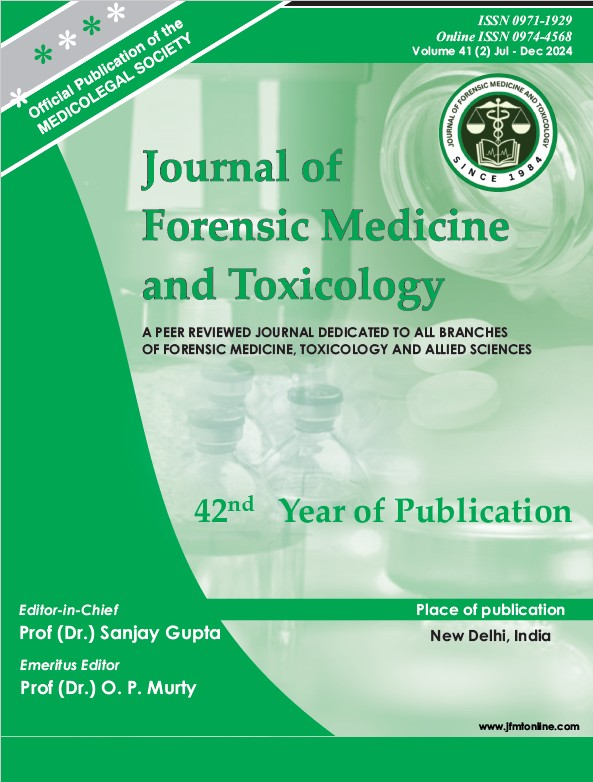Beyond the Scalpel: The Power of Questioning in Autopsy and chasing the truth – a case series
DOI:
https://doi.org/10.48165/jfmt.2025.42.2.20Keywords:
Forensic medicine, Medico-legal autopsy, DNA analysis, Scientific rigour, Professional disagreementsAbstract
The word autopsy is derived from the Greek term autopsia, meaning to “see for oneself ” and is the keystone of forensic medicine. The medico-legal autopsies in India are performed at the request of an investigative officer as guided under the Bharatiya Nagarik Suraksha Sanhita (BNSS) 2023, replacing the former Criminal Procedure Code (CrPC) 1973. A com plete and meticulous autopsy is always necessary, as minor omissions can lead to misinterpretation of findings, affecting judicial outcomes. Post-mortem artefacts and handling-related alterations can further complicate the interpretations, resulting in obscure or negative autopsies where no definitive cause of death is established. Incongruities among forensic experts can sometimes create professional disagreements, yet such wide-ranging outlooks can ultimately enhance justice delivery. This article presents a case series highlighting the significance of preserving trivial evidence, conducting a com plete post-mortem examination, and looking at the post-mortem case through an open-eyed approach. Through three post-mortem cases, we demonstrate how scientific rigour, DNA analysis, histopathology, radiology, and toxicology con tributed to solving complicated cases. Our findings highlight the need for a systematic and neutral approach in forensic pathology to prevent wrongful accusations and ensure reliable post-mortem examinations
Downloads
References
Dehner, L. P. (2010). The medical autopsy: past, present, and dubious future. Missouri Medicine, 107(2), 94–100.
King, L. S., & Meehan, M. C. (1973). A history of the autopsy: A review. American Journal of Pathology, 73, 514–544.
The Bharatiya Nagarik Suraksha Sanhita. (2023). New Delhi: Gazette of India; No. 46 of 2023. https://www.mha.gov.in/sites/default/files/202404/250884_2_english_01042024.pdf
The Code of Criminal Procedure. (1974). India: Gazette of India. https://www.mha.gov.in/sites/default/files/2022-09/ccp1973%5B1%5D.pdf
Menezes, R. G., & Monteiro, F. N. (2025). Forensic Autopsy. In StatPearls [Internet]. Treasure Island (FL): StatPearls Publishing. https://www.ncbi.nlm.nih.gov/books/NBK539901/
Scendoni, R., Fedeli, P., Cannovo, N., & Cingolani, M. (2021). The “Magnificent Seven Errors” in forensic autopsy practice: The Italian context. Academic Forensic Pathology, 11(4), 208–214.
Benbow, E. W., & Roberts, I. S. (2003). The autopsy: complete or not complete? Histopathology, 42(5), 417–423.
Kumar, K., Kumar, V., Sharma, N., Gaba, K., & Kaushik, R. (2023). The definitive indefinite cause of death. Medical Research Archives, 11(12).
Cohle, S. D., & Sampson, B. A. (2001). The negative autopsy: sudden cardiac death or other? Cardiovascular Pathology, 10(5), 219–222.
Path, J. L. (1997). The obscure autopsy and neuroleptic malignant syndrome. Medicine, Science and the Law, 37(1), 79–81.
Rani, S., Nair, G. S., Shetty, S. S., Patel, M. C. S., & Arun, M. (2023). Death due to trauma or disease?–A case report. Journal of Forensic Medicine and Toxicology, 40(1), 121–124.
Turner, S. A., Barnard, J. J., Spotswood, S. D., & Prahlow, J. A. (2004). “Homicide by heart attack” revisited. Journal of Forensic Sciences, 49(3), 598–600.
Alvarez-Cubero, M. J., Saiz, M., Martinez-Gonzalez, L. J., Alvarez, J. C., Eisenberg, A. J., Budowle, B., & Lorente, J. A. (2012). Genetic identification of missing persons: DNA analysis of human remains and compromised samples. Pathobiology, 79(5), 228–238.
Kumar, N., Maitray, A., Gupta, R., & Shukla, S. K. (2018). Effects of preservative on foetus tissues and DNA profiling in forensic cases. International Journal of Molecular Biology, 3(4), 165–167.
Latham, K. E., & Miller, J. J. (2018). DNA recovery and analysis from skeletal material in modern forensic contexts. Forensic Science Research, 4(1), 51–59.
Cecchetto, G., Amagliani, A., Giraudo, C., Fais, P., Cavarzeran, F., Montisci, M., Feltrin, G., Viel, G., & Ferrara, S. D. (2012). MicroCT detection of gunshot residue in fresh and decomposed firearm wounds. International Journal of Legal Medicine, 126(3), 377–383.
Taborelli, A., Gibelli, D., Rizzi, A., Andreola, S., Brandone, A., & Cattaneo, C. (2012). Gunshot residues on dry bone after decomposition—a pilot study. Journal of Forensic Sciences, 57(5), 1281–1284.
Ramalingam, S., Veeravijayan, A., & Narayanan, S. (2023). A meticulous autopsy halts erroneous justice – Case report. Indian Journal of Forensic Community Medicine, 10(1), 52–56.




